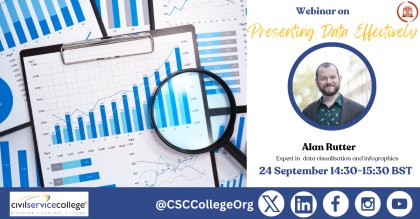Written by Ben Yardley, Learning Coordinator
To make good decisions at all levels of an organisation, data is crucial. Increasingly, public servants face pressure to prove that their conclusions are data-driven and supported by evidence; at any point, you may need to be able to answer the question, “What does the data say?”.
At the same time, it is easy for an audience to feel overwhelmed by too much data. No matter how well-researched or insightful your work is, if you lack the know-how to communicate your findings effectively then your work may be wasted.
On Tuesday, data visualisation expert and CSC associate trainer Alan Rutter shared his insights on how to use data effectively to tell a story and to communicate the information you need your audience to know. Alan has worked with organisations across the public and private sectors (including the Home Office, Department for Transport, NHS, Condé Nast and Vogue), helping to communicate data more effectively to stakeholders, senior leaders, colleagues and partners.
To watch the full webinar, see video at bottom of page
“You cannot unknow what you know” – stepping into your audience’s shoes
Alan summarises the problem that all specialists face as “the Curse of Knowledge”: that is, “you cannot unknow what you know”. It is incredibly difficult to imagine yourself in the position of somebody who understands much less about the subject matter than you do. Therefore, it is essential to be empathetic and to think carefully about how best to curate your message to your audience’s needs.
Alan lays out a simple three-point framework to consider when presenting data:
- Audience – who are you presenting to? What are their interests or preconceptions, and how much do they already understand about this subject?
- Story – what is the one single idea that you are trying to communicate?
- Action – what do you want your audience to do next?
The Audience-Story-Action framework is a helpful method for staying focused and making sure that you only communicate information that is important, actionable and notable. Think carefully about which information to include or exclude, making sure that you can justify why your audience needs to know what you are putting in front of them
Good chart, bad chart
There is no such thing as an inherently good or bad format for presenting data. It’s about finding the right tool for the job.
Understanding the needs of your audience is necessary for choosing which chart to deploy- or even whether a chart is the correct way to display the information in the first place. For example, a highly data-literate expert may not need a visualisation to aid understanding, preferring to see the data in spreadsheet form.
Conversely, a less data-literate reader will have very different needs. In this case, familiarity is your friend. A simple bar or line graph is likely to be far more effective than a less commonly-used format, such as a waterfall or radar chart. The very last thing that you want is for your reader to expend time and effort understanding the graph itself, rather than the information that the graph is trying to communicate.
Catching your reader’s eye- what do the experts say?
Most of us have an intuitive idea of what works for us. If pressed, we could probably conjure examples of good or bad charts that we have seen. But it is not always obvious whether another person will respond in the same way as us.
Luckily, academics in the field of graphical perception studies have conducted empirical research on how the human brain processes information most effectively. Research by Cleveland and McGill suggests that some ways of displaying difference on a chart are far more easily recognised than others. For example, the brain can discern elements such as position, length or direction much more quickly than shading or colour saturation. This doesn’t mean that you can never use shading on a graph! However, you should keep in mind it might not be the most effective way to communicate your ideas.
Alan also notes a concept called preattentive processing: the idea that the human brain will subconsciously try to recognise shapes or patterns before the conscious mind is engaged. He suggests ways to “hack” this by using techniques like colour or enclosure to direct your audience’s attention to what you want them to see first.
Remember: your goal as a communicator of data is to convey a single idea. By putting your audience first, building around one clear and actionable story, using familiar and intuitive charts and using simple design tricks to focus on key points, you can tell a story with data that will persuade and engage your audience.

